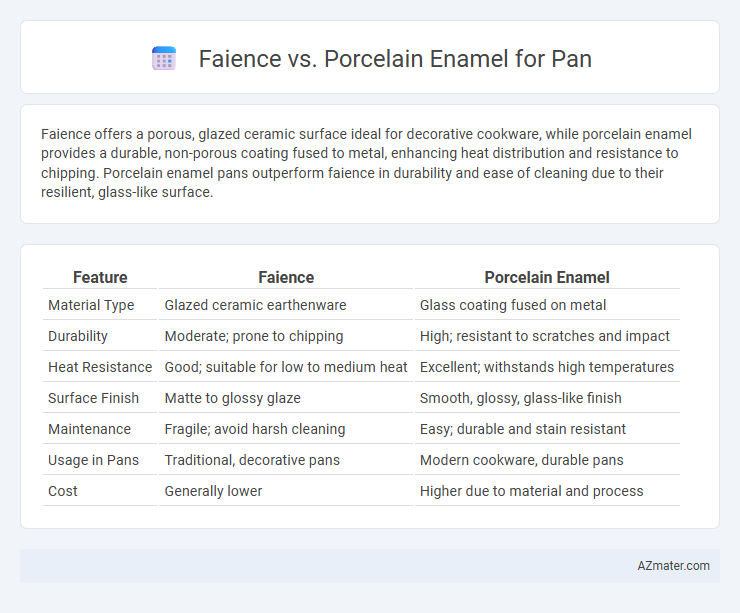Faience offers a porous, glazed ceramic surface ideal for decorative cookware, while porcelain enamel provides a durable, non-porous coating fused to metal, enhancing heat distribution and resistance to chipping. Porcelain enamel pans outperform faience in durability and ease of cleaning due to their resilient, glass-like surface.
Table of Comparison
| Feature | Faience | Porcelain Enamel |
|---|---|---|
| Material Type | Glazed ceramic earthenware | Glass coating fused on metal |
| Durability | Moderate; prone to chipping | High; resistant to scratches and impact |
| Heat Resistance | Good; suitable for low to medium heat | Excellent; withstands high temperatures |
| Surface Finish | Matte to glossy glaze | Smooth, glossy, glass-like finish |
| Maintenance | Fragile; avoid harsh cleaning | Easy; durable and stain resistant |
| Usage in Pans | Traditional, decorative pans | Modern cookware, durable pans |
| Cost | Generally lower | Higher due to material and process |
Introduction to Faience and Porcelain Enamel Pans
Faience and porcelain enamel pans differ primarily in their coating materials and manufacturing processes. Faience pans feature a tin-glazed earthenware surface known for its decorative finishes, while porcelain enamel pans are coated with a vitrified glass layer fused to metal, offering superior durability and heat resistance. Understanding these differences helps cook enthusiasts choose between the aesthetic appeal of faience and the functional advantages of porcelain enamel cookware.
What is Faience? Material Properties and Characteristics
Faience is a type of tin-glazed pottery known for its opaque, glossy surface created by applying a white glaze containing tin oxide, which provides excellent decorative qualities and vibrant colors. This ceramic material exhibits moderate porosity, making it less resistant to thermal shock compared to porcelain enamel, but it offers unique artistic appeal with its hand-painted designs. Faience's material properties include relatively low durability under heavy use and susceptibility to chipping, whereas porcelain enamel provides a more robust, non-porous, and chemically inert coating ideal for high-performance cookware.
What is Porcelain Enamel? Key Features and Benefits
Porcelain enamel is a durable coating made by fusing powdered glass to metal at high temperatures, creating a smooth, non-porous surface resistant to scratches, stains, and corrosion. This unique process enhances heat retention and distribution, making it ideal for cookware like pans, and offers easy cleaning without the use of harsh chemicals. The key benefits of porcelain enamel include its long-lasting durability, resistance to acidic and alkaline foods, and an attractive, glossy finish that does not chip or fade over time.
Durability Comparison: Faience vs Porcelain Enamel
Faience pans, made from tin-glazed earthenware, offer moderate durability but are prone to chipping and cracking under thermal stress. Porcelain enamel, fused to metal substrates like cast iron or steel at high temperatures, provides superior resistance to scratches, stains, and thermal shock, making it more durable for everyday cooking use. The dense, non-porous surface of porcelain enamel resists wear and maintains integrity longer compared to the more fragile faience finish.
Heat Conductivity: Which Pan Cooks Better?
Faience pans typically have lower heat conductivity due to their porous earthenware composition, resulting in uneven cooking and slower heat distribution. Porcelain enamel, applied over metals like cast iron or steel, offers superior heat conductivity and retention, enabling more efficient and consistent cooking performance. For precise temperature control and quicker heat response, porcelain enamel pans generally outperform faience pans in the kitchen.
Nonstick Performance and Ease of Cleaning
Faience cookware offers a natural nonstick surface due to its porous glaze, but it can be more prone to staining and sticking compared to porcelain enamel. Porcelain enamel pans provide a smooth, hard glass coating that excels in nonstick performance and resists food residue buildup, making them easier to clean and maintain. The durable, non-porous finish of porcelain enamel enhances longevity and simplifies cleanup compared to the more delicate faience glaze.
Aesthetic Differences: Colors, Patterns, and Design
Faience pans exhibit vibrant, hand-painted colors and intricate patterns reflecting traditional craftsmanship, often featuring floral or geometric motifs with a matte or slightly textured finish. Porcelain enamel pans offer a glossy, smooth surface with uniform coloration, typically available in solid, bright hues or subtle gradients, lending a modern and sleek appearance. The aesthetic distinction lies in faience's artisanal, decorative charm contrasted with porcelain enamel's clean, contemporary design palette.
Safety and Toxicity: Which is Healthier for Cooking?
Faience cookware, made from glazed earthenware, may contain lead or cadmium in its glaze, posing potential health risks if improperly manufactured or damaged. Porcelain enamel, a glass coating fused onto metal, is generally non-toxic, resistant to chemical leaching, and considered safer for cooking due to its inert and durable surface. Choosing porcelain enamel over faience reduces exposure to harmful metals, making it the healthier option for everyday food preparation.
Price and Availability: Finding the Right Pan for Your Budget
Faience pans typically offer a more affordable option compared to porcelain enamel, making them accessible for budget-conscious buyers. Porcelain enamel pans, while generally pricier, provide greater durability and resistance to chipping, influencing long-term value despite the higher upfront cost. Availability varies with regional markets, where faience cookware is often found in artisanal or specialty stores, whereas porcelain enamel pans are widely available through mainstream kitchenware retailers.
Choosing Between Faience and Porcelain Enamel: Final Verdict
Choosing between faience and porcelain enamel for pans depends on durability and heat retention needs. Faience offers a rustic aesthetic with moderate heat conductivity, ideal for slow cooking and decorative use. Porcelain enamel provides superior non-porous surfaces and greater resistance to chipping, making it more suitable for heavy-duty, everyday cooking tasks.

Infographic: Faience vs Porcelain Enamel for Pan
 azmater.com
azmater.com